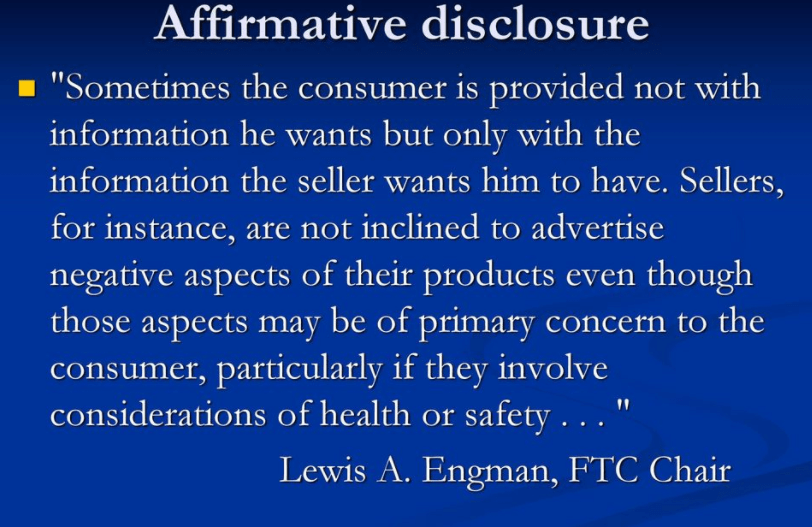Table of Contents
What is Affirmative Disclosure?
The advertisement contains Affirmative disclosure by providing customer information about the negative or harmful effects of the product/service. Such disclosure is made in accordance with government regulations and is generally not sought by the advertiser. Disclosure is not limited to product/service features, but may also include relevant information about offers made in advertising, especially in the case of exchange offers, sweepstakes, mystery gifts, money back offers, and gift vouchers.

The objective of Affirmative Disclosure
The objective of affirmative disclosure is to protect consumers from fraudulent and unethical marketing moves. Although natural competition and market mechanisms often ensure that consumers are well informed, there are situations where consumers are not exposed to all product/service features that affect their purchasing decision. Can be manipulated. In addition, positive disclosure also protects sellers from future liability claims. Since positive disclosure can trigger a significant change in attitude and behavioral intent towards a product/service, marketers are often wary of such disclosure.
One of the most common forms of Affirmative disclosure appears in cigarette advertising. The government has mandated the inclusion of a legal warning against smoking on the packaging, as well as promotional statements that “smoking is harmful to health.” Below is an example of such a statement.
The ‘Terms and Conditions’ block is another form of Affirmative disclosure that is widely used in promotional offers. Most food products clearly convey information about allergens such as peanuts and eggs. In addition, products that claim timely results or better results than their competitors should contain information about the testing process. If Fair & Lovely claims Fair Skin within 7 days in its statements, it will include an explanation of the test results made. Also, learn about the Brand development index.
Obligation regarding Affirmative Disclosure

5 Understanding U.S.C. 552 (a) (1)
U.S.C. 5 552 (a) (1) requires all federal agencies to publish the following types of information and records in the Federal Register:
- Ways and places to consult through the public for obtaining, requesting, or making decisions on the details and information of the central and regional agency of the agency.
- A statement describing how agency functions are determined and disseminated, including the requirements and nature of available informal and formal processes.
- Description of all available forms of the agency from which the forms are available, instructions for the content and scope of all tests, reports, or papers, and its rules of procedure.
- A description of the general application, the actual rules for such application, and the statement on the general policy formulated and approved,
- Cancels, amendments, or amendments to any of the above.
The clause also states:
Individuals who do not have timely and proper notification of agency regulations may not be adversely affected or resorted to by matters not published in the Federal Register.
However, if this material is made available to the affected persons, it will be deemed to have been published in the Federal Register when it is included as a reference to the approval of the Director of the Federal Register. Learn how online Ads work.
The head office of the agency must explain:
- Provide the address and location of the National Headquarters.
- Include a summary of all the departments in the agency headquarters.
- Specify the types of activities performed by the above sections.
- Describing the agency’s regional organization means you need to describe its organizational
- hierarchy. Typically, major regional centers are identified by their addresses. The outlines of the key staff chain of command may be included. Learn about ROAS in advertising.
If there are other places where people can get relevant information, they should also be identified.
The FOIA’s terms of proactive disclosure impose responsibility for affirmative disclosure on agencies and require that the categories of records specified in subsection (a) (2) of the FOIA be maintained and constantly updated. Learn about pop-up ads.
If you need help with affirmative disclosure, you can post your legal requirement on the UpCounsel Marketplace. UpCounsel only accepts the top 5 percent of lawyers on its site. UpCounsel lawyers come from prestigious law schools such as Yale Law and Harvard Law and generally have 14 years of legal experience, including working for or with companies such as Airbnb, Menlo Ventures, and Google.
Hope! You find this content informative. Don’t forget to share and leave Your comments. Thank you.






1 Comment